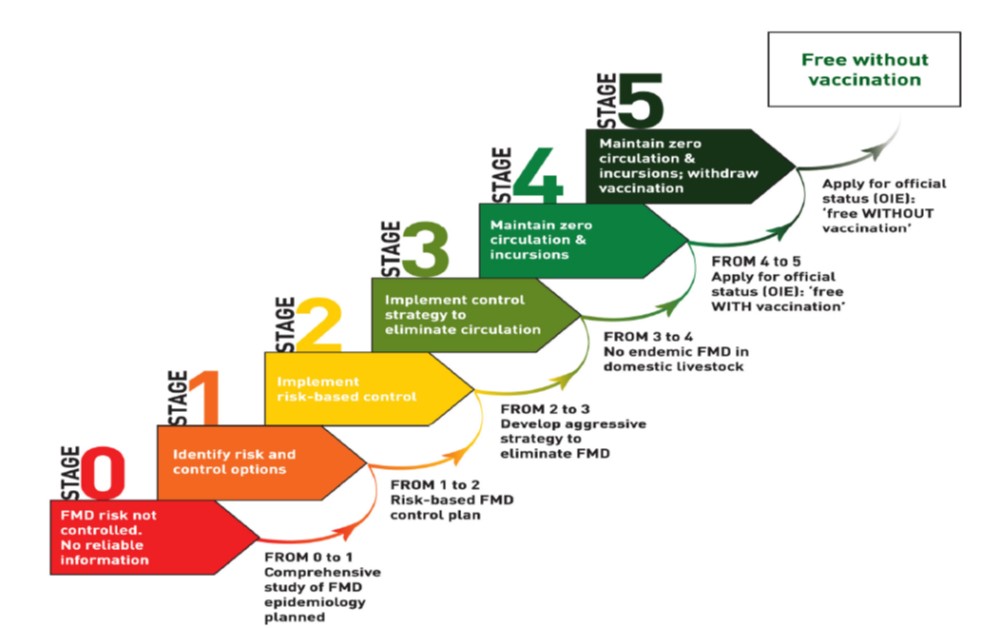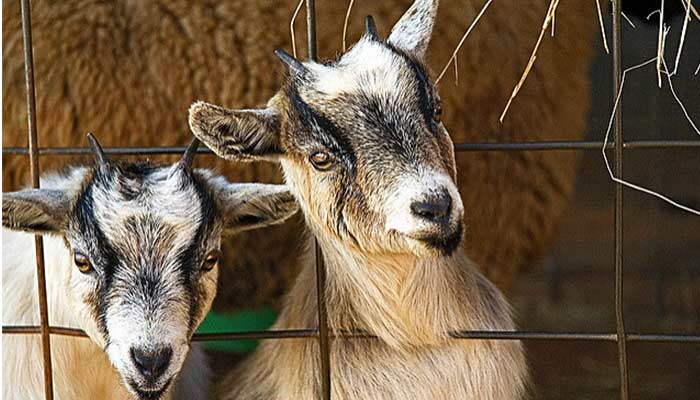Introduction to foot-and-mouth disease
Foot-and-mouth disease (FMD) is an infectious, highly contagious and acute disease of cloven-hoofed animals that include cattle, buffalo, sheep, goats, and around 70 species of wild animals [1]. FMD is currently endemic in Pakistan [2] and it is the most prevalent and economically the deadliest infectious disease of cattle and buffaloes in Pakistan [3]. Annual losses due to foot-and-mouth disease are estimated to exceed USD 692 million in terms of loss of milk production, treatment cost, bodyweight loss and mortality in calves [4].
International approaches to control foot-and-mouth disease
The OIE (Office International des Epizooties) has given motivation to the idea of moving towards global freedom from FMD. It is being done by providing international standards and strategies to empower a system for officially identifying OIE member countries free from the foot and mouth disease.
To further facilitate the trade in animals and animal products, the standards for officially recognizing entire member countries free from FMD have been gradually extended to recognize free zones within infected countries. Furthermore, disease-free compartments within zones have also been suggested. It is being done to identify more animal and animal products that can be traded as safe supplies irrespective of the fact whether a country is free from FMD with vaccination or vaccination is being applied to control the disease.
Currently, out of the 177 OIE member countries, 65 countries are free from FMD without vaccination, 1 free with vaccination, 10 countries having zones free without vaccination and 6 countries zones free with vaccination [5].

Role of FAO in controlling foot-and-mouth disease in Pakistan
Food and Agriculture Organisation of the United Nations (FAO) has been working for the control of FMD in Pakistan since 2008. On FAO-OIE FMD Progressive Control Pathway (FMD-PCP), Pakistan has moved from stage 0 to stage 1 in 2009 and to stage 2 in 2015. Recently, FAO and Ministry of National Food Security and Research, Pakistan has signed a USD 6.6 million project agreement in Islamabad titled “Risk-based control of Foot and Mouth Disease in Pakistan”.
Hopefully, this project will move Pakistan to stage 3, opening up further international markets for the export of meat and other livestock products. FAO will implement this project over the next 6 years to help control FMD in Pakistan [4]. The project will address the Foot-and-Mouth Disease laboratory diagnosis, outbreak investigation and speedy response, delivering high-quality vaccines for prevention, refining legal framework, and capacity building of the stakeholders. This will eventually curtail losses caused by the disease, increase the productivity of livestock and improve livelihoods.
Status of the foot-and-mouth disease in Pakistan
The population of cattle, buffalo, sheep and goat in Punjab, Pakistan, as reported in recent Livestock Census Punjab 2018, is 14.94, 14.12, 6.05 and 14.56 million, respectively, and more than 50% of this livestock population is located in South Punjab [6]. FMD is the most prevalent infectious disease of livestock in Pakistan. Based on participatory disease search studies, the prevalence of FMD in Punjab is estimated to be in the range of 10-53% [7].
Analysis of NSP antibodies against FMD virus by ELISA, 78% of cattle and buffaloes in the dairy colony production system and 61% cattle in the Cholistan had NSP antibodies against FMD. In smallholder dairy production system in villages, the prevalence of NSP antibodies against FMDV was 37% in Jhang, 29% in Attock and 19% in Rahim Yar Khan districts [3]. A total of 150 FMD outbreaks were reported in Punjab in January 2017. Out of 150, 99 outbreaks were caused by serotype O, 3 each by serotype A and Asia-1, while 3 and 42 outbreaks were caused by mixed type and untyped serotypes [8]. This number decreased to 62 reported FMD outbreaks in Punjab in February 2018 [2]. Out of 62 outbreaks, 18, 27 and 1 were caused by O, A, and Asia I FMD serotypes while 1 outbreak was caused by mixed serotypes and 11 were caused by un-typed serotypes [2].
These studies indicate that FMD is widespread in Punjab and progressive control of FMD through vaccination is the best strategy.
Controlling foot-and-mouth disease by vaccination
As vaccination plays important role in prevention and control of FMD, it has been practically proved that well-formulated quality vaccines containing appropriate strains of FMD can provide protection against FMD in Pakistan [3]. Ideally, the vaccine should contain recently circulating FMD virus strains. Based on genotyping and vaccine matching studies, as per information provided by FAO Progressive control of FMD in Pakistan, O/Pan Asia 2, A/Turkey 06, and Asia 01/Sindh 08 vaccine strains are providing excellent protection against FMD field strains in Pakistan [3].
Current situation of FMD in Punjab, Pakistan dictates that FMD vaccination is direly needed in Punjab in general and South Punjab in particular, especially the districts which were not included in the previous vaccination campaign. Massive vaccination involving 100% animal population including cattle, buffalo, sheep, goats and wild ruminants is suggested to minimize the risk of FMD spread from unvaccinated animals. Trivalent vaccines incorporating matching strains within serotypes O, A and Asia-1, as recommended by FAO Progressive control of FMD in Pakistan, should be used and be complemented with livestock movement control for the control of the disease.
The significance of diagnostic facilities in foot-and-mouth disease surveillance
Along with vaccination, further studies on the characterization of FMD virus types responsible for field outbreaks from different geographical areas would be helpful in the selection of proper strains/subtypes for incorporation into vaccines. For active FMD surveillance, use of serological and molecular diagnostic tools is mandatory to exclude the diseases that might confuse with FMD. For this purpose, increasing the diagnostic capacity of existing district disease diagnostic laboratories along with the development of new diagnostic facilities in Punjab is required. Such strong measures will help in the control and eventual eradication of FMD in Pakistan.
References
- Brehm, K.E., et al., Highly sensitive fetal goat tongue cell line for detection and isolation of foot-and-mouth disease virus. J Clin Microbiol, 2009. 47(10): p. 3156-60.
- Foot-and-Mouth Disease Situation, Food and Agriculture Organization of the United Nations, Monthly Report, D. Gizaw, Editor. February 2018.
- Pakistan FMD Bulletin. Progressive Control of FMD in Pakistan, GCP/Pak/123/USA. July-September 2014.
- Govt joins hands with FAO to control FMD, in The Nation. June 21, 2018.
- Gideon Brückner, V.E.S.-V., OIE Strategy for the Control and Eradication of Foot and Mouth Disease at Regional and Global Levels, in Conf. OIE 2010. 2010. p. 187-198.
- Livestock Census Punjab 2018, First Real Time (Door to Door) Livestock Census June 2018: Livestock & Dairy Development Department, Punjab Civil Secretariat, Lahore, Pakistan.
- Afzal, M., Pakistan: FMD Current Scenario, presentation by Chief Executive Livestock and Dairy Development Board, Islamabad.
- Foot-and-Mouth Disease Situation, Food and Agriculture Organization of the United Nations, Monthly Report, A. Shimshony, Editor. January 2017.



Leave a Reply